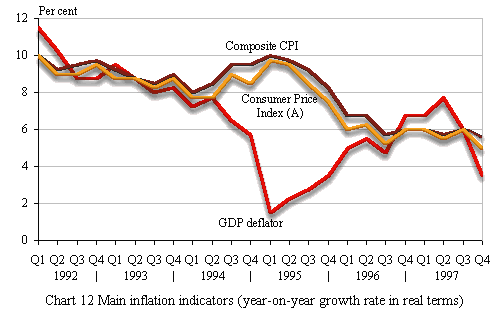Inflation
Consumer price inflation moderated further in 1997. There was little price
pressure from imported sources, owing to the sustained strength of the
US dollar, generally soft world commodity prices, and low inflation in the
major supplier economies such as the Mainland, Japan and the USA.
Domestically generated inflationary pressures were largely contained, even
amid the buoyancy in the early part of the year. The increases in wages
and rentals were not particularly rapid. Sustained productivity
improvement helped keep local prices in check. During the latter part of
the year, inflationary pressures eased as the economy slackened upon the
impact of the regional financial turmoil.
The Composite Consumer Price Index rose by an average of 5.8 per cent
in 1997, representing a continued easing from the 6.3 per cent increase
in 1996. The year-on-year rate of increase in the Composite CPI largely
followed a softening trend during 1997, save for a mild pick-up in the
third quarter due to a temporary upsurge in vegetable prices caused by
wet weather. The CPI(A), CPI(B) and Hang Seng CPI showed broadly
similar movements. The GDP deflator, as a broad measure of overall
inflation in the economy, rose by 5.9 per cent in 1997, faster than the
5.4 per cent increase in 1996.
Chart 12 Main inflation indicators
(year-on-year growth rate in real
terms) Consumer price inflation moderated further in 1997.

[Back] [Forward]
|